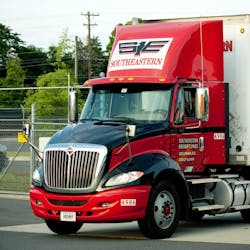Understanding what fatigue is and how to manage it effectively – through rest, sleep, diet and exercise, even tractor specifications – is a critical component to fostering what Tom DiSalvi calls the “safety payoff” in trucking operations.
“The biggest piece of truck transportation planning is how to insure drivers are well rested so they can stay alert,” DiSalvi, VP for safety and loss prevention at Schneider, told Fleet Owner.
“For us, that starts with education through driver training: gaining an understanding about the sleep cycle, sleep debt, sleep hygiene, and proper fatigue management,” he explained.
That encompasses a broad range of subjects, too, such as how to find safe overnight parking spaces while on the road to spec’ing tractor interior to be more conducive for comfort and rest – thus fostering more alertness for drivers.
“It’s about helping drivers be more prepared so they understand the warning signs of fatigue and also know how to counteract it,” DiSalvi said. “We then help tie that into our safety expectations. The whole idea is that the driver is the ‘captain of the ship’ and the need to have the right information to know if they are too tired to drive.”
The “payoff” from this focus on fatigue, he added, is that not only improving the safety profile of the fleet but improving driver retention as well. “It develops a stronger and more [positive relationship between drivers and front-line managers,” DiSalvi noted.Southeastern Freight Lines (SEFL) took that strategy a step further by implementing a sleep apnea interdiction program designed by FusionHealth back in 2011.
The fleet tested FusionHealth’s system by using one group of some 100 drivers with sleep apnea enrolled in the firm’s program compared to a second group of roughly 100 with the same gender, age, job, claims-based expenditures and medical conditions that didn’t use it.
Within the first year of using the FusionHealth system, with a compliance rate of over 90%, the SEFL group using its sleep apnea program demonstrated a reduction in medical and pharmacy costs of 5% while in the case-control group those costs actually increased by 11%.
More Importantly, SEFL witnessed what it dubbed an “immediate” impact in terms of accident savings, with preventable accidents in the FusionHealth group dropping by 45% compared to a 48% increase among the control group – helping generate $600,000 in total cost savings within one year.
Based on those results, SEFL is expanding FusionHealth’s across its entire driver workforce; a process that should be completed by the end of this year.
“One of the big motivating factors in all of this was looking at the number of accidents that are fatigue related,” John Pryor, SEFL’s VP of human resources and safety, told Fleet Owner.
Yet he noted that voluntary program for SEFL’s drivers required some up-front dedication to work – noticeable improvements wouldn’t be felt for two to three weeks – so the carrier involved the driver’s families and spouses in the program, too.
“It doesn’t hurt to have a spouse saying, ‘Now I get a full night’s sleep because he’s not snoring anymore,’” Pryor said. “It’s creates a healthier and safer environment for all concerned.”
About the Author
Sean Kilcarr
Editor in Chief
Sean Kilcarr is a former longtime FleetOwner senior editor who wrote for the publication from 2000 to 2018. He served as editor-in-chief from 2017 to 2018.

